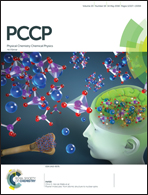Dependence of hot electron transfer on surface coverage and adsorbate species at semiconductor–molecule interfaces†
Abstract
Developing a molecular-level understanding of how a hot electron transfer process can be enhanced at semiconductor–molecule interfaces is central to advancing various future technologies. Using first-principles quantum dynamics simulations, we investigate how surface coverage and molecular adsorbate species influence the hot electron transfer at semiconductor–molecule interfaces. Counterintuitively, hot electron transfer from the semiconductor to molecules was found to be lessened with increased surface coverage because the inter-molecular interaction changes nonadiabatic couplings across the semiconductor and adsorbed molecules. The adsorbate molecular species itself was found to be an important factor in hot electron transfer not simply because of the energy level alignments at the interface, but also because the transfer is quite sensitive to nonadiabatic couplings. Our work shows that relatively minor variations of the couplings could lead to significant changes in hot electron transfer characteristics at semiconductor–molecule interfaces. Controlling nonadiabatic couplings must be part of developing a molecular-level “design principle” for enhancing hot electron transfer in addition to the well-recognized importance of energy level alignments.



 Please wait while we load your content...
Please wait while we load your content...
